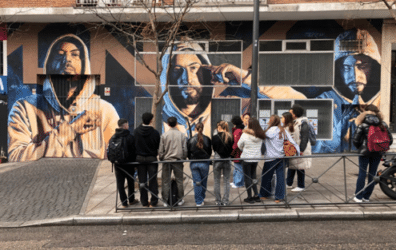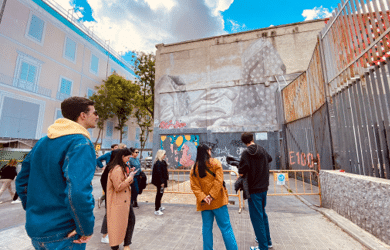Learning a new language is often seen as a challenge. It requires hard study. In this sense, our Spanish intensive courses in Madrid include vocabulary, grammar, and pronunciation. However, street art and other forms of visual art, such as graffiti, may offer an immersive and engaging way to learn Spanish, providing a cultural context that enriches understanding and retention.
By using art as a tool for language acquisition, young and adult learners may discover vocabulary and grammatical structures in a natural setting. This article will explore within the next paragraphs how street art, murals, and other artistic expressions may serve as a great resource to learn Spanish, offering a vibrant and meaningful alternative to conventional language-learning methods.
Street art as a visual dictionary

Urban art, in its simplest form, is a form of communication. It often conveys powerful messages, emotions, and hidden stories which combine images and words. In several Spanish cities, street art can be found almost everywhere, covering the walls of places such as Barcelona, Valencia or Alicante. Moreover Madrid graffiti murals provide an excellent opportunity for language learners to encounter Spanish in its most authentic form, and close to Academia Contacto!
One of the most compelling reasons to use art for language learning is the cultural immersion it provides. Street art, in particular, is a reflection of the socio-political environment of a place, often commenting on issues like inequality, human rights, and identity.
By engaging with this art, learners do not only pick up the language, but they also gain insight into the Spanish-speaking communities’ cultural values.
In this sense, we’ve created a new partnership with Cooltourspain, a service provider for street art tours in Madrid. Thanks to this 2024-2025 collaboration, students will be granted a 30% discount when booking online. Once you place your reservation, please write them an email at info@cooltourspain.com, with the code ACADEMIACONTACTO, so that they send you a payment link.
Vocabulary acquisition:
Street art is often filled with simple, yet impactful words or phrases. For instance, a mural might feature the word "amor" (love), surrounded by hearts or embracing figures. Seeing the word in such a visually stimulating context helps the learning process. Other common words found in street art include "paz" (peace), "libertad" (freedom), and "justicia" (justice). These words are often repeated across various pieces, reinforcing multiculturalism and respect to others.
Contextual learning:
Unlike a traditional vocabulary list, street art provides context. The word "amigos" (friends) painted on a wall surrounded by images of children playing together creates a narrative that helps learners understand how the word is used in real-life situations.
Exploring grammar through art

For some students, grammar might be the most challenging skill while learning a new language. Despite that fact, art in general terms may provide a natural and less intimidating way to approach Spanish grammar, than a common textbook.
Sentence Structure:
Many urban art walls include short sentences or slogans, such as the one painted by a famous crew called Boa Mistura. The quote stated, "Somos lo que hacemos para cambiar lo hacemos" (We’re what we do, in order to change who we are).
These slogans offer a glimpse into Spanish sentence structure, showing how verbs, nouns, and adjectives are used in real-life contexts. Analyzing these sentences can help learners understand subject-verb agreement and word order, crucial aspects of Spanish grammar.
Verb tenses:
Furthermore, graffiti walls painted at middle, or high schools often include verbs in different form tenses. For example, a mural might depict a call to action like "Lucha por tus derechos" (Fight for your rights), using the imperative form of the verb "luchar" (to fight).
Other artworks might feature slogans with verbs in the present tense, such as "Nosotros creemos en la paz" (In peace we trust). Observing these verbs in their natural setting helps learners to understand and remember different conjugations, making grammar study less abstract and more connected to real-world usage.
Cultural immersion and understanding

One of the most compelling reasons to use art for language learning is the cultural immersion it provides. Street art, in particular, is a reflection of the socio-political environment of a place, often commenting on issues like inequality, human rights, and identity.
By engaging with this art, learners do not only pick up the language, but they also gain insight into the Spanish-speaking communities’ cultural values.
In this sense, we’ve created a new partnership with Cooltourspain, a service provider for street art tours in Madrid. Thanks to this 2024-2025 collaboration, students will be granted a 30% discount when booking online. Once you place your reservation, please write them an email at info@cooltourspain.com, with the code ACADEMIACONTACTO, so that they send you a payment link.


